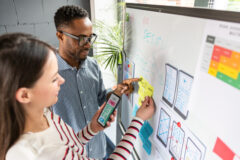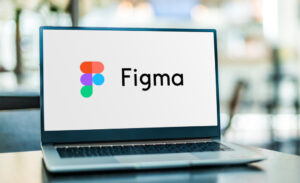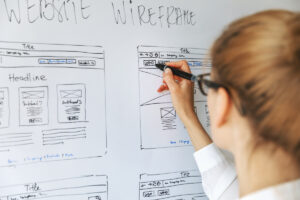As the guarantor of the quality of the user experience of a digital product or service, the UX designer plays a key role in the development of the product. role key. What techniques does it use to improve user recruitment, satisfaction and loyalty? What skills do they need to master? And how much do they earn? Ornella Solari, Talent Acquisition Manager at Ludotic, gives us the lowdown on this key job?

The term "UX" is an abbreviation of the English user experience, which can be translated into French as user experience. It refers to the experience of a person using a product or service. In other words, what they experience in terms of pragmatism, comfort, pleasure or the subjective values they attach to the product or service.
Although the UX designer is often associated with the design of digital products, such as websites, applications or video games, their field of intervention can go beyond this. Service design also calls on UX.
For a physical shop, for example, a UX designer can guide a customer's path between the shelves, follow how they interact with the products, immerse them in a particular atmosphere, and so on. The UX designer can therefore intervene in many areas. However, the digital sector remains his favourite. This is the angle from which we will look at the specific features of this profession.
UX designer, a profession now firmly rooted in organisations
To understand this profession, let's take a quick look at the past.
In the early days of digital technology and the web, UX design was an emerging field based on the expertise of two very different but complementary profiles:
- The ergonomist which, above all guarantee effectiveness, efficiency and usability new technological and digital services. It used the ISO 9241 standard to design screens and interfaces that are intuitive and easy to use, even for novices.
- Le graphic designer, was at the service of this ergonomics and had to bring the interfaces to life by making them attractive and desirable. His palette of tools included typography, colours, illustrations, etc.
The explosion of e-commerce and the emergence of mobile applications have brought the start-up model to the fore. Their value is based in part on the number of users they are able to acquire and retain in a very short space of time, thanks to an experiential pathway.
So, in this race for innovation, where the design thinking UX design has developed as the main vehicle in increasingly agile organisations.
Ergonomics is no longer enough to respond to the paradigms of innovation. We need to understand not only the user's mental model, but also their cultural universe, uses and emotions before, during and after interaction with a digital service or product, in order to offer them a fully-fledged experience. From user experience to customer experience. But does the UX designer have the same missions and the same role in all organisations? Are these organisations looking for the same skills?
UX designer, the stages of the job
There is, of course, a common portrait for the UX designer, whatever the organisation. The UX designer contributes to each of these stages:
User search
Understanding the user by using qualitative and quantitative survey methods (observations, interviews, questionnaires, analytics, etc.). It is also through user and usability tests that we can orientate the right design.
The approach discovery.
In the case of a new product or functionality launch, this involves exploring problems, solutions, uses and users in order to define a value proposition.
Experience mapping
The UX designer organises the information gathered in the workshop (working meetings in small groups), conceptualises new paths using a number of tools such as the experience map (graphic representation of the user experience of a product or service), the empathy map (graphic representation of user needs and expectations), the blueprint service (graphical representation of interactions between users and the various players in a service).
Functional modelling
The UX designer conceptualises the results of the research and mapping to design the main stages of interaction.
Graphic design
Working with the UI designers who design the interface, the UX designer finds graphic components that are sufficiently intuitive and useful for users' needs, and that correspond to the product's graphic universe.
Depending on the maturity of the company and the budget allocated, the emphasis may be placed on certain stages and not others. Let's take a look at the specifics that may be required.
The UX design of a consumer product
In this case, the users may be end consumers (customers of an e-commerce site, taxi service, banking service, etc.). Users of a public service (public sites for declaring tax, obtaining a bus route, declaring a GP, etc.).
In these areas, the broader the UX designer's range of skills, the better.
What knowledge and training do you need to become a UX designer?
- The practice and use oftools for analysing user insights are highly valued by companies marketing digital products and services: Hotjar, Google Analytics, Dovetail, etc.
- Experience in agile environments.
Knowledge work in a sprintbe totally at ease using collaborative modelling or project management tools (FigmaFigjam, Jira, Mural, Klaxoon, Axure RP, Sketch...)
- Knowledge of accessibility
The mission of the UX designer is not necessarily linked to the design of the website.accessibility, as defined by the RGAA. Nevertheless, digital accessibility emphasises the importance of thinking in terms of the "user" and considering the difficulties experienced by certain individuals with motor, cognitive or sensory disabilities.
- Creative and graphic skills
This is not the case in all sectors, but it is clear that digital departments appreciate highly creative UX designers, whether to produce more colourful mock-ups or to present stakeholders with more visual and less verbose user research results.
- Know-how
L'empathy Of course, it's a skill that is honed through practice, the ability to find compromises.
What special features can be requested?
Experience in the design of voice-activated interfaces, experience of the conversational agentstype chatbotwhich also requires skills in UX writing.
Which departments does the UX designer work with?
The development, product marketing, communications and customer service teams.
What are the prospects for development?
This depends very much on the organisation's UX design maturity, but several positions are possible: UX strategist, UX researcher, UX lead or even UX director.
What training courses?
The level of training required will depend on the criticality and complexity of the sector of activity. For example:
- Masters in design schools
- Training in the human sciences (5 years' higher education in cognitive psychology or sociology), provided that the profile also includes additional experience in design and the digital world.
- Master's degree in ergonomics under the same conditions.
- The short courses in UX and UI A master's degree in transformation or digital marketing is also a good choice.
How much will I be paid?
- Remuneration varies widely from one sector to another
- 28 k€ per year for a junior
- up to €80k for a senior profile in a fast-growing business sector
The UX designer at the service of business software or an industrial product
In the so-called "critical" sectors and professions, the end user is not a consumer, but a professional. The aim is not to sell them an "experience" at any price, but above all to guarantee usability and efficiency, without any risk to the nature of the task they are carrying out.
An error could have serious consequences for the company or its environment.
These include medical software, medical imaging software, command and control software, navigation software, attack software in the defence sector, etc.
In this type of sector, ergonomic skills are particularly sought after.
In the Industry 4.0 era, everything is going digital, and these are complex processes that need to be understood and mapped.
Recommended skills and training?
- Advanced knowledge of user research: here, it is the methodology that counts, the risk of error is standardised and rigour is imposed on the drafting of an interview or observation protocol. As with the analysis of results, knowledge of statistics may be required depending on the project.
- A precise analysis of the task, an experience map, is not enough to cover the risk of error.
- An understanding of the human factor and the conditions that encourage the risk of error (fatigue, stress, sleep, mental workload, etc.)
- The ability to take an auditor's approach to IS teams. In the industrial world, a lot of off-the-shelf software is purchased. The UX designer is there to identify the solution that is closest to your needs.
What special features can be requested?
- Knowledge of a particular sector of activity, skills in 3D prototyping to design solutions adapted to mixed or virtual reality.
- People skills: being a UX designer in this world requires precision, analysis and a sense of winning over stakeholders. In the industrial world or in sectors such as defence, which are not always agile, decision-making takes longer. The UX designer is there to establish links with the various teams and get things moving.
- What kind of collaboration? Innovation labs, development teams, the IT department, the industrial and quality department, teams of physical ergonomists.
- What are the career prospects? The career prospects are relatively similar: UX project manager (managing UX projects), UX lead, UX manager (managing a UX team).
What training is required for this type of position?
Above all, it is experience that will prevail. However, a foundation of solid training in ergonomics can be searched for.
- Masters degrees in cognitive ergonomics or information systems are in demand.
- Postdocs in ergonomics too.
- Engineering schools specialising in design and ergonomics.
How much will I be paid?
- Remuneration varies widely from one sector to another
- 30 k€ per year for a junior profile
- Up to €80k for a specialist senior profile
UX designer, a dream job?
The strengths of this profession :
- One of the first advantages of this job is its cross-functional nature: as a UX designer, you're connected to all the strategic areas of the organisation.
- Keeping in touch with reality on the ground
- A profession with a mission: a mission that gives meaning to what we do: a career in UX design is above all about exploring and creating to provide a useful and usable service to human beings.
The difficulties of the job :
- Arbitrating between the technical constraints of a product, the business and the allocated budget. The job of UX designer requires you to constantly make compromises in favour of the user.
- Meeting deadlines. There is a very wide range of user-centred tools, but not all methods are compatible with a budget and project deadlines.
The future of the UX designer
Over the years, the role of the UX designer has evolved, becoming more specialised and articulated according to a particular sector, business and user typology.
Specialisation is the first indicator that the role is fundamental and needs to be developed further.
IT is a good example of how the developer profession has expanded and evolved. There are mobile developers, full stack developers and front end developers...
In the same way, today we find UX designers who are more B-to-C oriented, others who are B-to-B, e-commerce specialists, or specialists in the banking-insurance sector, and so on.
But the future of UX design also lies in eco-design challenges, where it will have to guarantee users an experience that respects the environment, but also human ecology. This last discipline is important for the future of UX design, as it will enable us to respond to users' growing concerns about sustainability.





